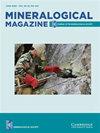具有GIS框架型结构的矿物新资料:来自德国Bellerberg火山的gismondine- sr和来自以色列Hatrurim杂岩的amicite和富钡gismondine
IF 1.4
3区 地球科学
Q2 MINERALOGY
引用次数: 0
摘要
gismondine sr最近在以色列Hatrurim杂岩中被发现,并在德国Bellerberg火山的包体样品中被识别出来。经验晶体化学式表明K含量升高:(Sr1.74Ca1.05Ba0.09K1.56Na0.49)Σ4.93[Al7.98Si8.06O32]⋅9.62H2O。此外,在Hatrurim杂岩热变质岩的低温矿物组合中发现了富ba的gismondine和amicite。给出了所研究沸石的拉曼光谱和第二次产状的吉斯蒙-锶的晶体结构。对具有GIS框架型结构的沸石进行了综述,得出以下结论:(1)榴石-钠和戈壁石是等效的,并与榴石-钙构成固溶体;(2) gismontin - ca、-Sr、amicite属于一个矿物系列;(3)在GIS拓扑结构中可以区分出两个具有不同R-因子(定义为Si/(Si+Al+Fe))的沸石系列:包括榴石-钙和gobbinsite的榴石系列(R > .6),通式为(MyD0.5(x-y))[AlxSi(16-x)O32]⋅nH2O,其中M和D分别为一价和二价阳离子;和gismondine系列,包括amicite, gismondine- sr和gismondine- ca, R≈0.5,通式(MyD0.5(8-y))[Al8Si8O32]⋅nH2O。475 cm-1 ~ 485 cm-1之间的拉曼带是加罗岩系的特征带,而460 cm-1左右的拉曼带是吉斯蒙丁系的特征带。在此基础上,建议对GIS沸石命名法进行修订。本文章由计算机程序翻译,如有差异,请以英文原文为准。
New data on minerals with the GIS framework-type structure: gismondine-Sr from the Bellerberg volcano, Germany, and amicite and Ba-rich gismondine from the Hatrurim Complex, Israel
Abstract Gismondine-Sr, recently discovered in the Hatrurim Complex in Israel, has been recognised in a xenolith sample from the Bellerberg volcano in Germany. The empirical crystal-chemical formula indicates elevated K content: (Sr1.74Ca1.05Ba0.09K1.56Na0.49)Σ4.93[Al7.98Si8.06O32]⋅9.62H2O. Additionally, Ba-rich gismondine and amicite have been found in the low-temperature mineral association of the pyrometamorphic rock from the Hatrurim Complex. The Raman spectra of the studied zeolites and the crystal structure of gismondine-Sr from the second occurrence are presented. A review of zeolites with GIS framework-type structure leads to the following conclusions: (1) garronite-Na and gobbinsite are equivalent and constitute a solid solution with garronite-Ca; (2) gismondine-Ca, -Sr, and amicite belong to one mineral series; (3) two zeolites series with different R-factors (defined as Si/(Si+Al+Fe)) can be distinguished within GIS topology: the garronite series (R > 0.6) including garronite-Ca and gobbinsite, with general formula (MyD0.5(x–y))[AlxSi(16–x)O32]⋅nH2O, where M and D refer to monovalent and divalent cations, respectively; and the gismondine series, including amicite, gismondine-Sr and gismondine-Ca, with R ≈ 0.5, and the general formula (MyD0.5(8–y))[Al8Si8O32]⋅nH2O. The Raman band between 475 cm–1 and 485 cm–1 is distinctive for the garronite series, whereas the band around 460 cm–1 is characteristic of the gismondine series. On the basis of these findings, a revision of GIS zeolites nomenclature is suggested.
求助全文
通过发布文献求助,成功后即可免费获取论文全文。
去求助
来源期刊

Mineralogical Magazine
地学-矿物学
CiteScore
4.00
自引率
25.90%
发文量
104
审稿时长
6-12 weeks
期刊介绍:
Mineralogical Magazine is an international journal of mineral sciences which covers the fields of mineralogy, crystallography, geochemistry, petrology, environmental geology and economic geology. The journal has been published continuously since the founding of the Mineralogical Society of Great Britain and Ireland in 1876 and is a leading journal in its field.
 求助内容:
求助内容: 应助结果提醒方式:
应助结果提醒方式:


